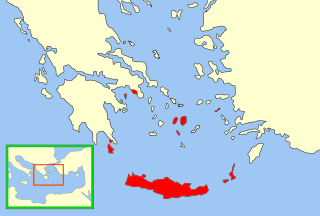Related Research Articles
Karbeas, also Karbaias (Καρβαίας), was a Paulician leader, who, following the anti-Paulician pogroms in 843, abandoned his service in the Byzantine army and went over to the Arabs. With the aid of the emir of Melitene, Umar al-Aqta, he founded the Paulician principality of Tephrike, which he ruled until his death in 863. During this period he participated alongside Umar in several raids against the Byzantine Empire.

Umar ibn Hafs ibn Shuayb ibn Isa al-Balluti was the leader of a group of Andalusi refugees who seized control of Alexandria and, after being expelled from the city by the Abbasids, conquered the Byzantine island of Crete, becoming the first Emir of Crete.

The Emirate of Crete was an Islamic state that existed on the Mediterranean island of Crete from the late 820s to the reconquest of the island by the Byzantine Empire in 961. Although the emirate recognized the suzerainty of the Abbasid Caliphate and maintained close ties with Tulunid Egypt, it was de facto independent.
ʿUmar ibn ʿAbdallāh ibn Marwān or ʿAmr ibn ʿUbaydallāh ibn Marwān, surnamed al-Aqtaʾ, and found as Amer or Ambros in Byzantine sources, was the semi-independent Arab emir of Malatya (Melitene) from the 830s until his death in the Battle of Lalakaon on 3 September 863. During this time, he was one of the greatest threats to the Byzantine Empire on its eastern frontier, and became a prominent figure in later Arabic and Turkish epic literature.
Abu Muhammad Lu'lu', surnamed al-Kabir and al-Jarrahi al-Sayfi, was a military slave (ghulam) of the Hamdanid Emirate of Aleppo. Under the rule of Sa'd al-Dawla, he rose to become the emirate's chamberlain, and on Sa'd al-Dawla's death in 991 he was appointed guardian of his son and successor, Sa'id al-Dawla. The able Lu'lu' soon became the de facto ruler of the emirate, securing his position by marrying his daughter to the young emir. His perseverance and aid from the Byzantine emperor Basil II preserved Aleppo from repeated Fatimid attempts to conquer it. Upon Sa'id al-Dawla's death in 1002—possibly poisoned by Lu'lu'—he became the ruler of the emirate, disinheriting Sa'id al-Dawla's sons. He ruled with wisdom until his death in 1008/9. He was succeeded by his son, Mansur, who managed to retain the throne until deposed in 1015/16.
Abdallah al-Battal was a Muslim Arab commander in the Arab–Byzantine Wars of the early 8th century, participating in several of the campaigns launched by the Umayyad Caliphate against the Byzantine Empire. Historical facts about his life are sparse, but in Anatolia, a legendary tradition grew around him after his death, and he became a famous figure in Turkish epic literature as Battal Gazi.

The Battle of Kardia was a naval battle fought in c. 872/3 between the fleets of the Byzantine Empire and the Cretan Saracens off Kardia, in the Gulf of Saros. The battle was a major Byzantine victory.
Photios was a Byzantine renegade and convert to Islam who served the Emirate of Crete as a naval commander in the 870s.
Abu ʿAmr Shuʿayb ibn ʿUmar ibn ʿIsā al-Balluti, also Saet or Saïpes (Σαΐπης) in the Byzantine sources, was the second Emir of Crete, ruling c. 855 – c. 880.
Abū ʿAbdallāh ʿUmar II ibn Shuʿayb al-Balluti, also Babdel in the Byzantine sources, was the third Emir of Crete, ruling c. 880–895.
ʿAbd al-ʿAzīz ibn Shuʿayb ibn ʿUmar al-Qurṭubī al-Ballūṭī, known as Kouroupas in the Byzantine sources, was the tenth and last emir of Crete, ruling from 949 to the Byzantine reconquest of the island in 961.
Al-Nu'mān ibn ʿAbd al-ʿAzīz ibn Shuʿayb ibn ʿUmar al-Qurṭubī, known by the Byzantines as Anemas, was the son of the last Emir of Crete, Abd al-Aziz ibn Shu'ayb. Following the Siege of Chandax and the reconquest of Crete by the Byzantines, Anemas and his father were taken as prisoners to Constantinople and displayed during the triumph of the conqueror and future emperor Nikephoros II Phokas.
Qarghuyah or Qarquya was an important Arab administrator in the Hamdanid Dynasty under Sayf al-Dawla, who would go on to control Aleppo himself and even sign the Treaty of Safar with the Byzantine Empire as the ruling emir of Aleppo.
Yusuf ibn Umar ibn Shu'ayb was the fifth Emir of Crete, reigning from c. 910–915.
Ali ibn Yusuf ibn Umar was the sixth emir of Crete, reigning from c. 915–925.
Ahmad ibn Umar ibn Shu'ayb was the seventh emir of Crete, reigning from c. 925–940.
Shu'ayb ibn Ahmad was the eighth Emir of Crete, reigning from c. 940–943.
Ali ibn Ahmad was the ninth Emir of Crete, reigning from c. 943–949.
Abu Abdallah al-Husayn ibn Nasir al-Dawla was a Hamdanid prince, who along with his brother Ibrahim was the last Hamdanid ruler of Mosul in 989–990. After his defeat at the hand of the Marwanid Kurds and the takeover of Mosul by the Uqaylids, he entered the service of the Fatimid Caliphate.
Abu Tahir Ibrahim ibn Nasir al-Dawla was a Hamdanid prince, who along with his brother al-Husayn was the last Hamdanid ruler of Mosul in 989–990. After his defeat at the hand of the Marwanid Kurds, he was killed by the Uqaylid leader Muhammad ibn al-Musayyab, who usurped rule over Mosul for his family.
References
- ↑ Miles 1964, pp. 11–14.
- ↑ Canard 1971, p. 1085.
- ↑ PmbZ, Muḥammad b. Šu‘ayb (#25437).